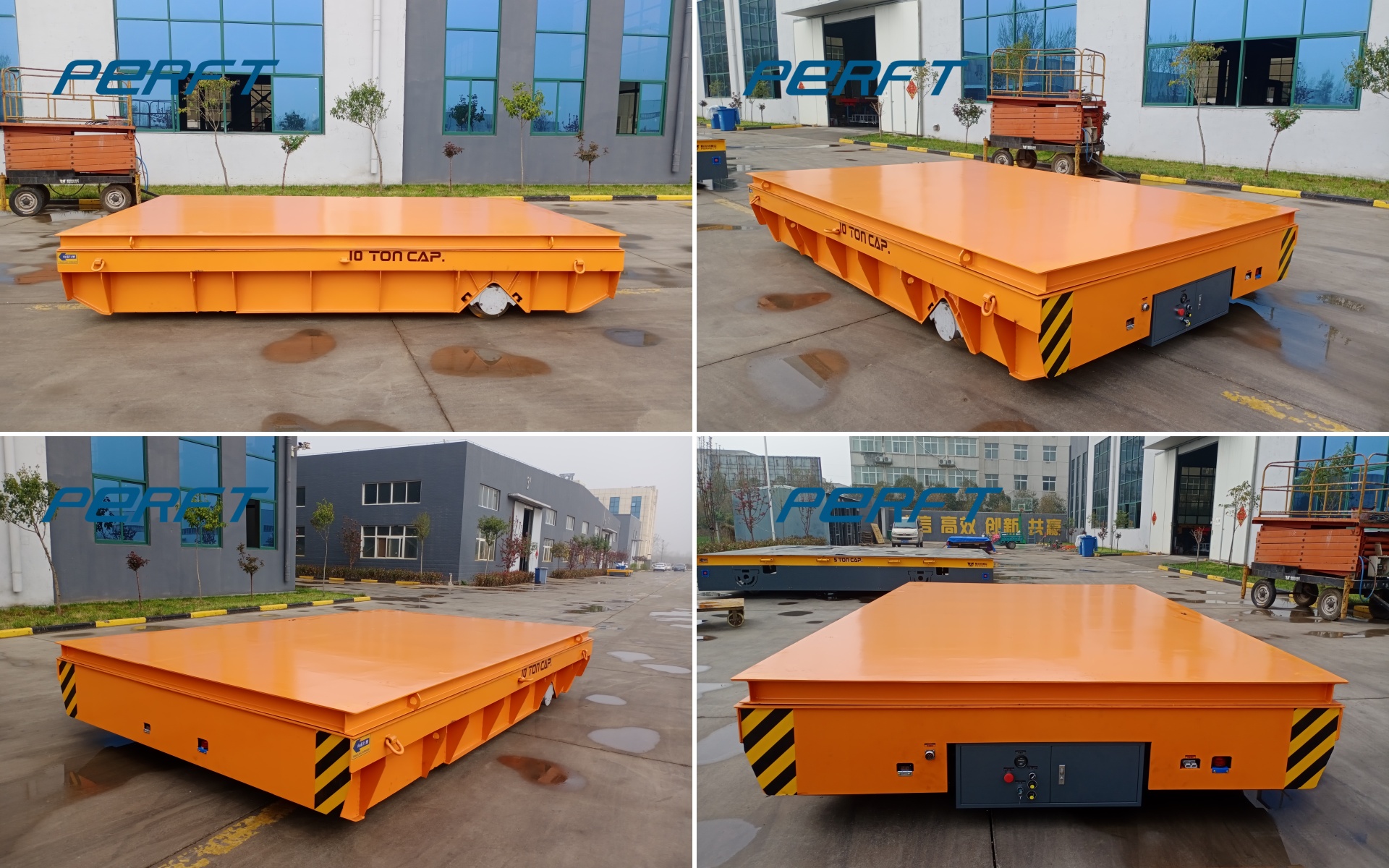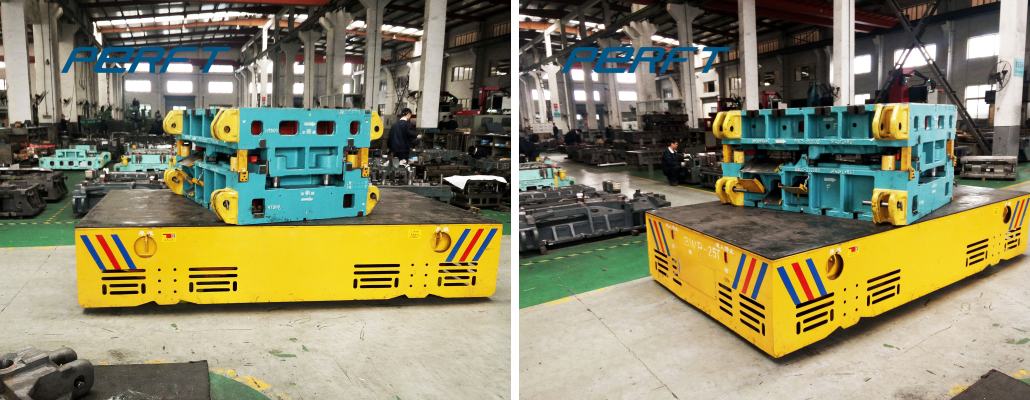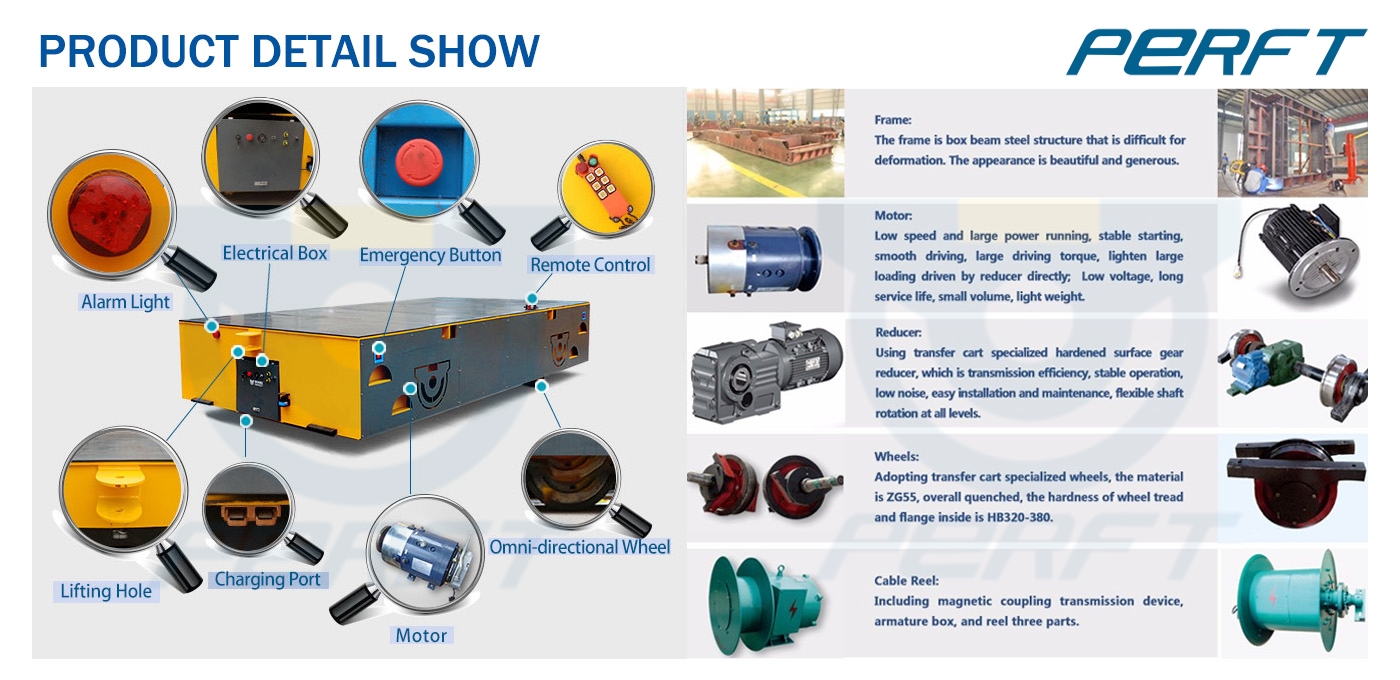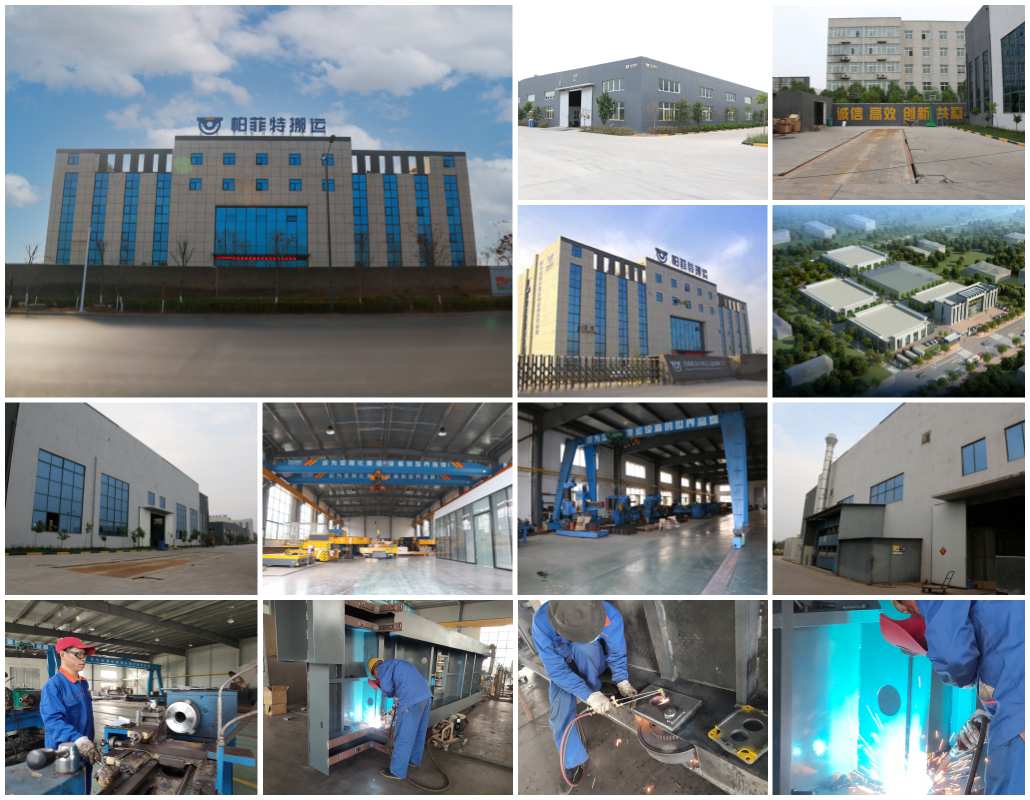In the wave of intelligent manufacturing and green logistics, electric transfer trolley is becoming an indispensable core tool for material transportation in modern industrial scenarios with zero emissions, high load, and intelligent features.

Working Principle of Electric Transfer Cart
- Power Supply System: As the power source, the choice of battery determines the endurance of the equipment and the applicable scenarios.
-Lead-acid batteries: Low cost, simple maintenance, suitable for short distances, low-frequency operation, but the weight is large, and low energy density.
-Lithium batteries: High energy density, fast charging, longer life, support high-frequency operations, gradually becoming the mainstream choice.
-Fuel cell: Fueled by hydrogen energy, zero emissions, and long range, suitable for closed scenes with high environmental requirements.
- Motor System: The motor is responsible for converting electrical energy into mechanical energy to drive the wheels, and the two mainstream types are adapted to different needs.
-DC motors: With excellent speed regulation and fast response capability, they are suitable for production line handling scenarios with frequent starts and stops, such as automotive assembly workshops.
-AC motors: With an efficiency of more than 90% and significant energy-saving features, they are suitable for logistics and warehousing scenarios that require long and stable operation.
- Intelligent Controller: The controller adjusts the motor speed in real time by receiving operation signals (e.g., accelerating, braking), and its intelligent design gives the equipment multiple safety guarantees.
-Overload protection: Automatically reduces the speed when the load exceeds the rated weight to avoid motor burnout.
-Undervoltage protection: Triggers an alarm and restricts operation when the battery power falls below a critical value to prevent over-discharge.
- Regenerative braking: Recovering energy back to the battery during braking to enhance energy utilization.
-Reducer and Drivetrain: The reducer increases torque by lowering the speed, ensuring that the wheels receive sufficient driving force.
-Gear reducer: Compact and high ratio, suitable for high load scenarios (e.g., transportation of steel coils in steel mills).
-Planetary reducer: Low noise and high impact resistance, suitable for precision workshops that require a high degree of quietness in the working environment.
- Auxiliary system: The charging system supports fast charging (1-2 hours full) and slow charging (6-8 hours) modes, adapting to different operating rhythms. The electric steering system and intelligent instrument panel simplify the operation process, reduce manual fatigue, and improve operational safety.
Transfer Cart Battery Power 10 Ton Video
Types of Electric Transfer Carts
Classification according to structure and function
Flatbed Transfer Carts: The most common type, the open plane table, can carry pallets, boxes, and small machinery, widely used in warehouse sorting and internal transportation.
Heavy-Duty Transfer Carts: Adopting a thickened steel structure and double motor drive, the load capacity can reach hundreds of tons, specially designed for large equipment (such as generator sets).
Turntable: The table is equipped with a 360°rotating platform, which can complete loading and unloading in narrow aisles without turning around, and improve the space utilization rate by more than 30%.
Classification according to power and navigation
Battery Powered Transfer Trolleys: Get rid of the cable bondage, support the free movement of the whole scene, suitable for large-scale warehousing centers with an area of more than 10,000 square meters.
Cable Reel Powered Transfer Trolleys: Connected to a fixed power supply through the cable, suitable for long-distance continuous operation (such as the end of the production line to the storage area of the fixed route transportation).
Rail Guided Transfer Trolleys: Running along the preset track, positioning accuracy of ±5mm, suitable for high repeatability, safety requirements of the scene (such as lithium battery production line).
Trackless Transfer Trolleys: Equipped with laser navigation or magnetic stripe navigation system, they can freely plan the path on the flat ground, and flexibly adapt to the mode of multi-species small batch production.
Customized Solutions
Perfect Transfer Cart and other professional manufacturers can provide highly customized products: high-temperature-resistant transfer carts (resistant to environments of more than 300 ℃) for the metallurgical industry, explosion-proof models to meet the safety standards of the chemical workshop, and models equipped with lifting platforms can be directly docked to the shelves for high level access.
Features of Electric Transfer Carts
- Super Load Capacity: The standard model can carry 1-50 tons, and the heavy-duty customized model can even reach 500 tons, which can easily cope with the transportation needs of oversized parts such as automobile body-in-white, ship segments, etc., and reduce the time-consuming and loss of traditional forklift trucks for multiple transfers.
- Flexible Customization: From table size (can be customized to 20 meters long version) to functional modules (such as integrated load cell, RFID read/write device), all of them can be developed according to customers’ needs, avoiding the waste of efficiency of “standard equipment for special scenarios”.
- Durability & Reliability: Aircraft-grade aluminum alloy and wear-resistant steel are used for key components, which have passed a 1,000-hour continuous operation test, with an MTBF of more than 8,000 hours, significantly reducing downtime and maintenance costs.
- Low Maintenance Costs: The modular design allows for quick replacement of core components such as motors and controllers, and routine maintenance only requires checking battery status and tire wear, reducing average annual maintenance costs by more than 60% compared to diesel equipment.
- Safety and Environmental Protection: Zero-emission feature complies with ISO 14001 environmental standards, especially suitable for food processing, pharmaceutical production, and other sensitive air quality scenarios. Anti-collision sensors and emergency braking systems reduce the accident rate to 1/5 of traditional equipment.

Applications of Electric Transfer Carts
Manufacturing and Production Line
In the automobile manufacturing workshop, heavy duty transfer carts are responsible for transporting the whole vehicle chassis and engine assembly, with the rail system to achieve precise positioning assembly, so that the production cycle of a single vehicle is shortened by 20%.
The machining industry through trackless transfer trolleys to facilitate the flexible transfer of large castings to different machining stations to reduce the waiting time for the traveling crane lifting.
Logistics and Warehousing Center
In the e-commerce warehouse, battery driven turntable carts can quickly complete the steering and sorting of palletized goods, with an hourly processing efficiency of more than 500 pallets.
In the cold-chain logistics scenario, the low-temperature-resistant model (-30℃ environment stable operation) guarantees the continuous transportation of fresh products.
Steel and Metal Processing
Hot rolled steel mills use high-temperature-resistant transfer trolleys (surface temperature ≤60℃) to directly transport freshly rolled steel coils, with a single load of up to 30 tons.
Metal product mills use customized models equipped with a weighing system to achieve accurate measurement of raw materials in and out of the warehouse.
Shipbuilding and Marine Engineering
In the shipbuilding base, 500-ton heavy duty transfer trolleys are responsible for transporting hull segments, and with the laser navigation system, to achieve millimeter-level positioning and docking, which shortens the ship assembly cycle by 30%.
In the port scenario, electric flatbed carts can be directly docked with the container cranes, completing the efficient shore-to-store transfer.
Power Plants and Heavy Industries
Explosion-proof transfer trolleys are used in thermal power plants to transport gas turbine components, and the zero-emission feature meets the safety requirements for indoor operations; nuclear power plants adopt fully sealed design models to prevent the risk of radioactive substance leakage.
Airports and Transportation Hubs
Driverless AGVs deployed in the cargo area of airports can automatically transport baggage containers along preset routes, with an average daily mileage of up to 50 kilometers per vehicle, which reduces labor costs and improves on-time performance to more than 99%.

How to Choose the Right Transfer Cart for Your Business
Define Load Requirements
-Calculate peak load: Consider cargo weight + pallet weight + vehicle weight, and reserve 20% safety redundancy (e.g., if the actual load is 20 tons, it is recommended to choose a 25-ton model).
-Special load shape: Long strip-shaped goods (such as steel pipes) need to be customized to lengthen the table, and irregular items need to be configured with non-slip fixtures.
Analyzes the Operating Environment
-Space limitation: Narrow channel (width <3 meters) preferred trackless carousel models, fixed route scenarios can be used to reduce the cost of rail-guided type.
-Environmental parameters: High-temperature workshop (>150 ℃) requires configuring the heat insulation layer, dusty environment should be selected fully enclosed motor.
Determine the Power and Range
-Operating hours: It is recommended to choose a Li-ion battery fast-charging model (80% replenishment in 1 hour) for more than 8 hours of operation in a single day.
-Energy costs: Cable reel models do not need to replace the battery, suitable for 24-hour continuous operation of the production line scenarios.
Function Module Customization
-Basic requirements: Standard LED warning light, emergency stop button, power display.
-Value-added configuration: GPS positioning (real-time tracking), remote control (for high-risk environments), and automatic charging (for AGV models) can be integrated in high-end scenarios.
Brand and Service Endorsement
Priority is given to manufacturers with ISO 9001 certification and 7×24 after-sales response, whose mature product line and customization experience can ensure that the project delivery cycle can be shortened by more than 40%.

